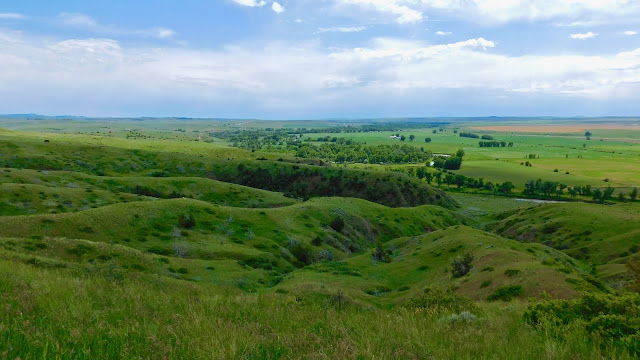Little Bighorn Battlefield - Part I
 |
| The Little Bighorn River Valley |
Located in south central Montana, the Little Bighorn Battlefield is a remarkable monument preserving a fascinating piece of American History. Here, General Custer and his battalion of 210 soldiers were massacred by a combined fighting force of Lakota and Cheyenne warriors.
What makes this memorial so unique is the scattering of marble markers that pinpoint the exact location of where each of the soldiers were killed. The white headstones' seemingly random arrangement betrays the sobering story they have to tell.
Upon approaching the Little Bighorn in early June, the spectacular scenery is as beautiful as any place on earth. Tall, green grass is windswept across the vast prairie of rolling hills that at one time supported thousands of buffalo.
Upon reaching the river valley, the terrain becomes more rugged as high bluffs to the east are broken by deep ravines and wide coulees. The serpentine-shaped thread of silver water is narrow, cold and deep.
Indians called it the Greasy Grass and this is where they were camped on June 25th, 1876. Custer was ordered to bring in the hostiles and he found them here, resting in the shade of lovely cottonwoods.
Despite the federal government's mandate to confine Native Americans to reservations, the Lakota and Northern Cheyenne had remained defiant, refusing to give up their independence and nomadic way of life.
The Black Hills was their homeland and it was promised to be theirs forever by the Fort Laramie Treaty of 1868. After the Civil War, westward expansion escalated as settlers, trappers and fortune seekers illegally desecrated the Indian's sacred hunting grounds.
As it appeared that conflict was inevitable, the northern tribes united under their spiritual leader Sitting Bull and military leaders Crazy Horse and Gall. Their paradise on the high plains was something worth fighting for.
On that hot, summer morning, the Seventh Cavalry under Lieutenant Colonel George Armstrong Custer rode down into the valley from the southeast. Custer divided his regiment of nearly 700 men into three battalions as he expected the Indians to scatter and run.
Captain Frederick Benteen took three companies and swung northwest to scout for stragglers and prevent escape in that direction. Major Marcus Reno was given three companies and ordered to charge due north into the south end of the camp.
Custer took five companies and headed northeast into the hills above. He was hoping to circle around to the opposite end of the camp, cross the river and attack in a pincer movement.
Reno's aggression provoked an unexpected force of 2,000 well-armed warriors. The Indians repulsed the initial attack and sent the terror-stricken bluecoats scurrying for cover in the nearby timber.
Amidst the chaos and confusion of the onslaught, Reno initiated a disorganized retreat across the river and up onto a high bluff. The shell-shocked troopers dug in and began a fight for their lives but where in the hell was Custer?
To be continued...
 |
| A remarkable monument |
 |
| Spectacular scenery |
 |
| A vast prairie |
 |
| Lovely cottonwoods on the Greasy Grass |
 |
| Conflict was inevitable |
 |
| Paradise on the high plains |
 |
| The Seventh Cavalry rode in from the southeast |
 |
| Reno charged north down the valley |
 |
| Where was Custer? |



Comments
Post a Comment